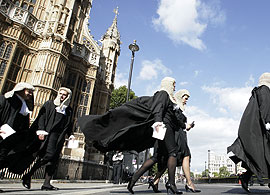Share it
 … that white men in possession of large fortunes are overly represented on the bench. Yet, while it is easy to label the judiciary as “too white, too male, too posh”, constructive solutions to the situation have proved difficult to implement. The 2010 report on judicial diversity recognised that “there is no quick fix to moving towards a more diverse judiciary … Sustained progress on judicial diversity requires a fundamental shift in approach from a focus on selection processes towards a judicial career that addresses diversity at every stage.” It is hoped that the current inquiry being carried out by the Lords Constitution Committee into the appointments process contributes a step towards this shift in approach. The Committee was tasked with examining a range of questions, including:
… that white men in possession of large fortunes are overly represented on the bench. Yet, while it is easy to label the judiciary as “too white, too male, too posh”, constructive solutions to the situation have proved difficult to implement. The 2010 report on judicial diversity recognised that “there is no quick fix to moving towards a more diverse judiciary … Sustained progress on judicial diversity requires a fundamental shift in approach from a focus on selection processes towards a judicial career that addresses diversity at every stage.” It is hoped that the current inquiry being carried out by the Lords Constitution Committee into the appointments process contributes a step towards this shift in approach. The Committee was tasked with examining a range of questions, including:
a. Does the judicial appointments process secure an independent judiciary?
b. Should Parliament scrutinise judicial appointments?
c. How can public understanding of the appointments process be improved?
d. Is the system based on merit?
e. Do we have a sufficiently diverse judiciary?
The Committee has heard evidence from an impressive roster of public figures, including Lord Phillips, Lord Judge, Lady Hale and Lady Neuberger. Yesterday it was the turn of Lord Neuberger and Lady Justice Hallett, neither of whom pulled any punches in their assessment of the current judicial appointments process and diversity of the judiciary.
Neuberger lays the blame for the lack of judicial diversity partially at the door of solicitors firms, who are reluctant to let female partners time out to become judges. Neuberger, The Guardian reports said that there was “enormous” reluctance among solicitors firms to their partners becoming part-time, let alone full-time, judges”. Solicitors who have become judges had admitted “their main problem was their partners”, the master of the rolls added. “Their partners are not evil people but they are looking at the hourly rate and keen to make as much money as possible and it’s very difficult for them to [appreciate that] their partners having other aims in life.”
Most judges, Neuberger said, are “white, public school men … It seems unfair that in a profession where more than 50% are women, that at the top we have such a small proportion of women … Why are 80/90% of our judges male? It seems that on statistical grounds we don’t have the best people.”
Lady Justice Hallett suggested that it was the workload that put off many women from either applying to, or staying at the bench. The normal pace of work for senior judges was now “frenetic” leading to “Women voting with their feet and saying life is too short. [They say] ‘We are working too many hours in the day and we forget the importance of family life’.” The result is that the UK is now lagging behind other countries in terms of the number of judges who are women or from ethnic minorities.
As ever, while it may be relatively straightforward to pinpoint the problems, solutions are more difficult. Neuberger is in favour of encouraging more solicitors to apply to the bench and encouraging the solicitors firms to see having partners sitting on the bench as a mark of prestige, as barristers chambers currently do. Neuberger also suggested that s 159 of the Equality Act should be used to give priority to women and other underrepresented groups if there are otherwise two equal candidates for a judicial post. However, this suggestion may well be met with accusations of tokenism.
The Committee continues to gather evidence and will be hearing from the chair of the Black Solicitors Network, a representative of the Association of Women Barristers and the chairwomen of the Association of Women Solicitors next week. It is unclear when the final inquiry report will come out, but when it does it will be interesting to see how the committee approaches the various solutions with which they have been presented.



1 comment